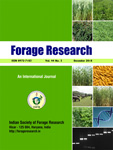ANIL KUMAR, CHANDER SHEKHAR, ANURAG AND SATPAL
Department of Agricultural Meteorology
CCS Haryana Agricultural University, Hisar-125 004 (Haryana), India
Department of Genetics & Plant Breeding (Forage Section)
CCS Haryana Agricultural University, Hisar-125 004 (Haryana), India
*(e-mail: anilmeteo@gmail.com)
(Received : 04 February 2025; Accepted : 27 March 2025)
SUMMARY
The main aim of this research work was to assess-profile micrometeorological conditions in
rainfed Pearl millet under varying growing environments in semi-arid region of Hisar,
Micrometeorological observation was measured at three phenophases (Tillering, Flag leaf and 50%
flowering) at hourly interval when attained the particular phenophases (decided on the basis of
visual observation) by used of Point quantum sensor, pyranometer with digital multivolmeter,
radiometer, soil heat flux plat and Asman Psychrometer. The upward and radiation fluxes are measure
of energy available at the crop canopy. The energy balance components namely net radiation (Rn),
latent heat flux/vaporization (LE), Sensible heat flux (A), and soil heat flux (G) reached the peak value
at sun overhead or noon and important of these were fundamental quantity of energy available to
drive the crop physiological process. Day time the energy flow results in the warming of pearmillet
leaf and within canopy air and crop surface quite cooling as outside soil surface. The percentage of
net energy utilized to the various components varies from pearmillet tillering to 50% growth stage
growth stages. Radiation use efficiency among the cultivars sown during 2nd fortnight of June
appeared to be at par with national check variety i.e. GHB 558 exhibiting surface remittance and
varietal characteristics. Absorption of radiation was increase from tillering to 50% flowering under
different growing environments. Decreased the utilization of LE in-advancement growth upto 50 %
flowering but in late sown D2 followed the D3 crop will utilized higher. An average transmission
higher at 50% flowering might be due to panicle erected vertically and leaves are bending toward the
stem with the minimized angle. The vertical PAR for favorable microclimatic profile patterns in pearl
millet crop was observed in 2nd fortnight of June sown. Thus, the higher grain yield was attained with
efficient utilization of micrometeorological variables during the course of the experiment year.
Key words: Weather relations, PAR, Energy balance, Latent heat flux, radiation component, microclimate

